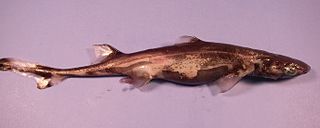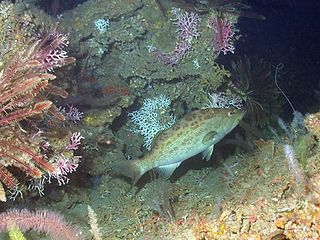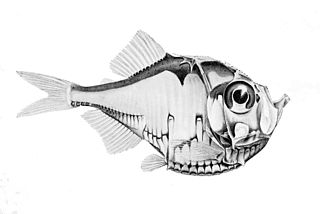
Marine hatchetfishes or deep-sea hatchetfishes are small deep-sea mesopelagic ray-finned fish of the stomiiform subfamily Sternoptychinae. They should not be confused with the freshwater hatchetfishes, which are not particularly closely related Teleostei in the characiform family Gasteropelecidae.

The king mackerelsurmayi or kingfish, is a migratory species of mackerel of the western Atlantic Ocean and Gulf of Mexico. It is an important species to both the commercial and recreational fishing industries.

Polyipnus is a genus of oceanic ray-finned fish in the family Sternoptychidae. This is the largest genus of the marine hatchetfishes subfamily Sternoptychinae and indeed of the entire Sternoptychidae. It is not quite as apomorphic as their relatives; it may be that the genus is actually a paraphyletic assemblage of less advanced Sternoptychinae and would need to be split.

The cherubfish, also known as the pygmy angelfish, is a species of marine ray-finned fish, a marine angelfish belonging to the family Pomacanthidae. It is found in the western Atlantic Ocean.

Argyropelecus hemigymnus, the half-naked hatchetfish, short silver hatchetfish or spurred hatchetfish, is a deep-sea hatchetfish of the genus Argyropelecus found mesopelagically in the Atlantic, Indian, and Pacific Oceans as well as in the Mediterranean Sea. It is a small species rarely exceeding 38 millimetres (1.5 in) standard length. It feeds on zooplankton, particularly ostracods and copepods. Sexual maturation occurs at length of about 22 mm, and adult males have more developed olfactory organs than females, i.e. the species is sexually dimorphic.

The gag grouper, also known as velvet rockfish, the gag, or charcoal belly, is a species of marine ray-finned fish, a grouper from the subfamily Epinephelinae which is part of the family Serranidae, which also includes the anthias and sea basses. It comes from warmer parts of the West Atlantic, including the Caribbean and Gulf of Mexico. It is a drab, mottled-gray fish lacking the distinguishing features of most other groupers. Its pattern of markings resemble the box-shaped spots of the black grouper. It lacks the streamer-points on the tail fin that scamp and yellowmouth grouper have and lacks yellow coloration around the mouth.

The Atlantic threadfin is a species of ray-finned fish, a threadfin from the family Polynemidae native to subtropical and temperate waters of the western Atlantic Ocean and the Gulf of Mexico.

The green lanternshark is a species of dogfish shark in the family Etmopteridae, found in the western central Atlantic Ocean. This species usually occurs on the upper continental slope below a depth of 350 m (1,150 ft). Reaching 26 cm (10 in) in length, the green lanternshark has a slender body with a long, thin tail and low, conical dermal denticles on its flanks. It is dark brown or gray with ventral black coloration, which contain light-emitting photophores that may serve a cryptic and/or social function. Green lanternsharks are thought to be gregarious and may attack their prey, squid and octopus often larger than themselves, in packs. Reproduction is aplacental viviparous, with females giving birth to litters of one to three young. This relatively common shark is an occasional, valueless bycatch of commercial fisheries; currently it does not appear to be significantly threatened by human activities.
The Monterrey Spanish mackerel is a species of fish in the family Scombridae. It is endemic to Mexico where it is found in the northern part of the Gulf of California. It is the subject of a fishery, its population is declining and the IUCN has rated it as being a "vulnerable species"

The scamp grouper, also known as scamp, is a species of marine ray-finned fish, a grouper from the subfamily Epinephelinae which is part of the family Serranidae, which also includes the anthias and sea basses. It is found in the western Atlantic Ocean.

Argyropelecus affinis is a species of ray-finned fish in the family Sternoptychidae, described by Garman in 1899, found in the tropical and subtropical Atlantic, Indian and Pacific Oceans. Common names for this fish include Pacific hatchetfish, deepsea hatchetfish and slender hatchetfish. It inhabits the upper mesopelagic zone between 350 and 600m during the day, and between 100m and 350m during the night and is either non-migratory or performs short daily vertical migrations. They are distributed widely throughout all tropical and temperate seas. They are known for its laterally compressed body and characteristic photophores, which aid in bioluminescence. Argyropelecus affinis is closely related to Argyropelecus gigas.

Argyropelecus sladeni, or Sladen's hatchetfish, is a species of ray-finned fish in the family Sternoptychidae, found in the tropical and subtropical Atlantic, Indian and Pacific Oceans. This small fish lives in the mesopelagic zone by day and makes a daily vertical migration to the epipelagic zone at night.

Sternoptyx diaphana, the diaphanous hatchetfish, is a species of deep sea ray-finned fish in the family Sternoptychidae. It is the type species of the genus Sternoptyx, and was first described by the French naturalist Johann Hermann in Der Naturforscher 1781.

Polyipnus asteroides, commonly known as the shortspine tenplate, is a species of ray-finned fish in the family Sternoptychidae. It occurs in deep water in the western Atlantic Ocean from the Gulf of Maine southward to the Caribbean Sea and the Gulf of Mexico. It occurs to a depth of about 500 metres (1,600 ft).

Polyipnus spinosus, commonly known as the spiny hatchetfish, is a species of ray-finned fish in the family Sternoptychidae. It occurs in deep water in the western central Pacific Ocean, at depths down to about 500 metres (1,600 ft).

Polyipnus triphanos, commonly known as the threelight hatchetfish, is a species of ray-finned fish in the family Sternoptychidae. It occurs in deep water in the Indo-Pacific Ocean, at depths between about 322 and 966 metres.

Polyipnus tridentifer, commonly known as the three-spined hatchetfish, is a species of ray-finned fish in the family Sternoptychidae. It occurs in deep water in the Indo-Pacific Ocean, at depths between about 640 and 825 metres.
Polyipnus latirastrus, commonly known as the combside hatchetfish, is a species of ray-finned fish in the family Sternoptychidae. It occurs in deep water in the western Pacific Ocean, at depths between about 696 and 888 metres.
Polyipnus polli, commonly known as the round hatchetfish, is a species of ray-finned fish in the family Sternoptychidae. It occurs in deep water in the eastern Atlantic Ocean, at depths between about 250 and 600 metres.
Polyipnus elongatus is a species of ray-finned fish in the family Sternoptychidae. It can be found in deep water in the southwestern Pacific Ocean around Australia, at depths down to about 400 metres (1,300 ft).















